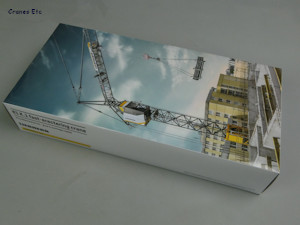 |
| Liebherr-branded
box. |
 |
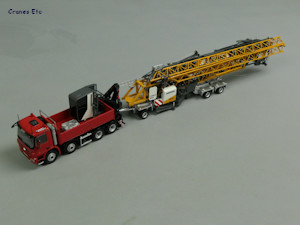 |
| As a transport
load. The truck is not included.
|
|
|
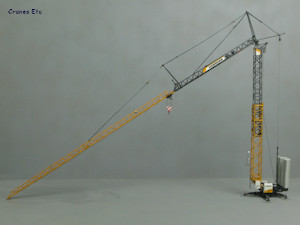 |
| Jib lowered.
The full erection equipment is not modelled so a
realistic erection
sequence cannot be replicated. |
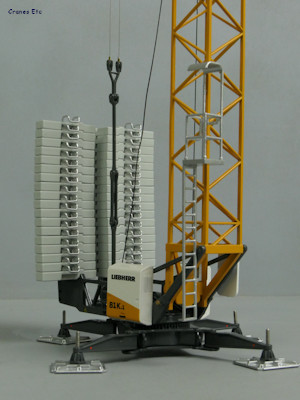 |
| Operator's
platform at the front.
|
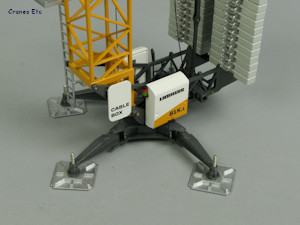 |
| Nice cabinets.
|
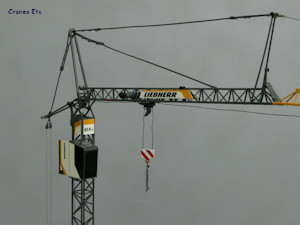 |
| Cab is a
separate part. |
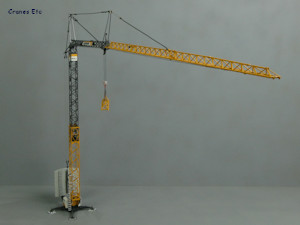 |
| Shortened jib
and without cab. |
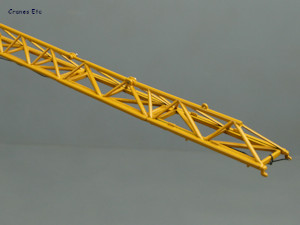 |
| End jib section is
pinned and removable |
|
The Liebherr 81 K.1 has a maximum lifting capacity of 6 tonnes and a maximum radius of 48m. It can lift 1.35 tonnes at maximum radius. It can operate at
various tower heights and can also climb using
additional tower sections.
This model also includes two dollies so that
it can be fully configured in a transport mode. It
is a revised and updated version of the previous 81 K
model.
Packaging
It comes in a Liebherr branded box and inside there is a two piece polystyrene tray containing
the parts, some of which are carefully wrapped.
There were no
missing parts on the review model, but a broken part was
quickly replaced by NZG.
An instruction sheet is provided for the
crane which is in
English and German. There is no information about
the real crane.
It is complex to assemble and the small hook block
is extremely difficult to reeve.
Detail
The base of the 81 K.1 has metal outriggers with simple screw thread
pads. Metal spreader plates are included. On top of the base is a toothed slewing
ring.
The cabinets are metal and nicely decorated, and the two
winches are good too.
The counterweight is a complete metal block with the Liebherr
name embossed, and step irons are included.
An extra four slabs is modelled which is presumably a modelling compromise
brought about by the need to counteract the heavy jib
and give the model some stability.
The mast sections are a good metal casting
although there are no ladders. An operator's
platform is mounted at the base. The rope-operated
mast raising system is modelled with small pulleys.
The cab is a separate part complete with access
platform, and it has heavily tinted windows. It is a
pity it does not have a lifting point so self-assembly
can be posed.
The complex jib consists of three
main sections which are metal and are fabricated as two castings;
the top sides and the bottom. The geometry and
profile of the erected jib is very good. The
trolley and erection motors are modelled as are the
Liebherr sign boards.
The suspension cables and
rods are high quality and a
very good job has been done to match lengths to obtain equalised tension. Both the trolley and hook are
metal and they are nice items. A small piece of
chain is included which adds detail and weight. It
is needed as the thread used for the hoist rope is not
the right flexibility to be free-flowing unless there is
some decent tension.
The two transport dollies are made to NZG's usual
standards. The wheels are metal with nice tyres
and are mounted on non-functioning suspension.
Features
The outriggers fold out but cannot be locked in
position so they move easily and have to be watched as
the crane overbalances if they are not set right. The
pads screw down.
The crane rotates.
Increasing the height of the mast using the winch is
implemented and it works well enough although the
rigging of the jib means only one height can be set so
it is not as flexible as the real crane.
The trolley can be positioned anywhere along the jib by
hand although it was 'sticky' on the review model at the
first articulation point.
The hook can be raised and lowered and works
reasonably well as long as there is some load on.
The cab can be fitted or left off. It would have
been nice if it had lifting points so that self assembly
could have been posed.
The crane can be erected and it is a large size.
The end of the jib is pinned and can be removed.
It can be
folded up with care. A tie needs to be used to keep
the folded jib in position.
The two transport dollies can be attached to the crane.
The rear one screws on and the front is a hook-over
pinned attachment. The front dolly steers to a good
angle and the tow bar raises and lowers.
Quality
The 81 K.1 is largely a metal model with some nicely
engineered parts, and it reasonably stands straight and
true.
The paint and graphics are very good.
Price
It is reasonable value for a complex model.
Overall
The 81 K.1 is an interesting and complex crane,
and it is substantially revised from the earlier 81 K
model. Compromises have had to be made in this scale
and so some of the functionality and flexibility of the
real crane is missing, and the model is close to the
limit of stability when standing. It is not really a
model for a beginner, but it certainly looks good and is
impressive.
Footnotes
The model first appeared
as the 81 K at the Nuremberg Toy Fair in 2013 with model #870. This
largely revised version appeared in 2023
|
|
|
|
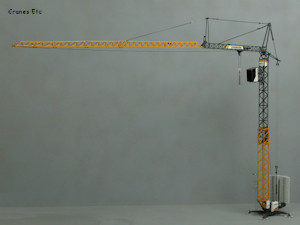 |
| The 81 K.1
ready for work. |
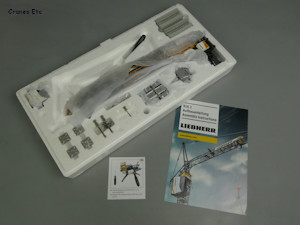 |
| The parts. |
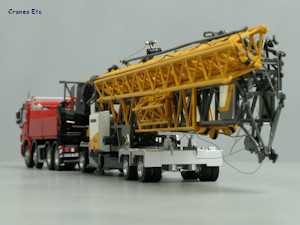 |
| Very complex.
|
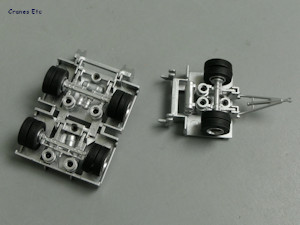 |
| Underside of
the dollies. |
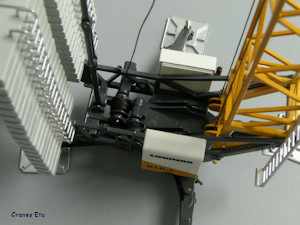 |
| Winches. |
|
|
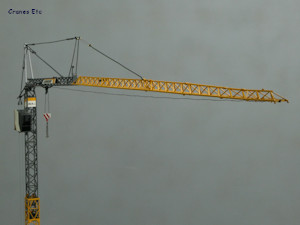 |
| Long jib. |
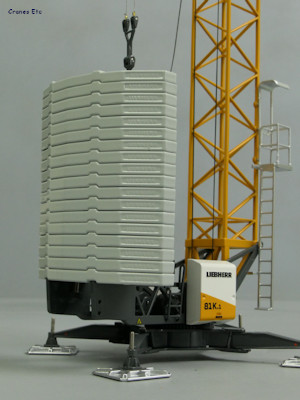 |
| Liebherr
embossed on the counterweight. |
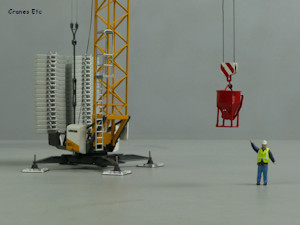 |
| At work. |
|

